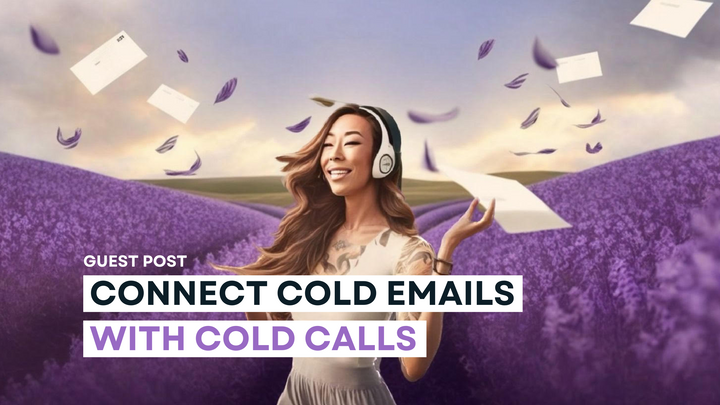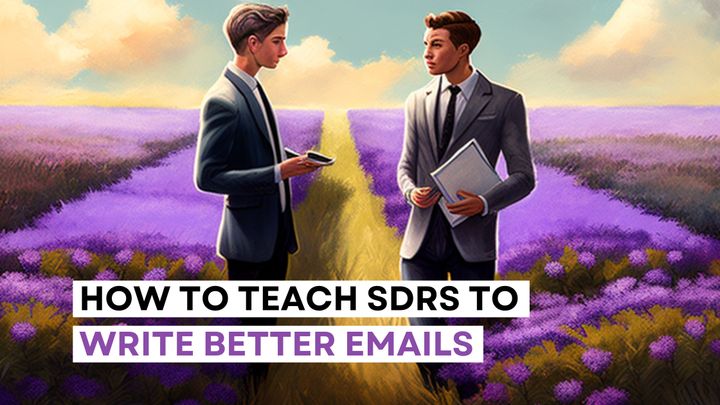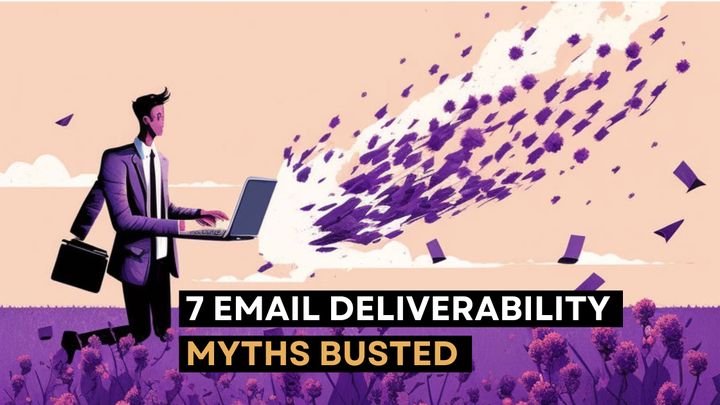Lavender’s Secret Sauce for Onboarding New SDRs
Onboarding can present challenges to a proper learning process. And for managers, it's difficult to measure onboarding efficacy. Unless, of course, you have Lavender. Here's how the tool dramatically helps onboarding.

Drinking from the fire hose is a metaphor commonly used to describe onboarding into a new role.
The phrase is most often viewed from the employee’s perspective: spending a few weeks inundated with company info, product demos, pain points experienced by customers, ideal customer profile analysis, competitive research, and much, much more.
What’s less common is the perspective of those doing the onboarding: the managers.
As someone who has created such processes and onboarded many employees in my career, it can also feel like you’re drinking from a fire hose.

(Ok, I know that’s a water hose, not a fire hose, but the idea still applies.)
To a certain extent, it is what it is. There’s a lot to learn, and you need to ramp new team members quickly and efficiently.
But there are two flaws in the traditional onboarding process.
- Most of what is learned is not retained.
- Managers don’t have enough leading indicators to tell them if onboarding is working until it’s too late. They need data sooner so they can be proactive. (More on this one later.)
At the end of any official training time, most of what's learned is not retained. That’s not how our brains work. Our brains need time and exercise to retain data properly.
There’s something called the “forgotten curve” in neuroscience.
“Research on the forgetting curve shows that within one hour, people will have forgotten an average of 50 percent of the information you presented. Within 24 hours, they have forgotten an average of 70 percent of new information, and within a week, forgetting claims an average of 90 percent of it,” writes Art Kohn, a professor for the Aspire Consulting Group.
🤯
This training scenario can be especially troublesome for sales teams. For example, you need new sales development representatives (SDRs) to get up to speed as fast as possible and start outbounding.
And if they're not ready once they start executing, you’ll only learn that if they tell you. Or you’ll realize after they fall behind on producing revenue or pipeline. That feeling of not knowing makes it feel like more fire hose drinking for you as their manager.
(While simultaneously making your onboarding process seem flawed.)
Lavender improves onboarding quality, efficiency, and efficacy while also tackling other challenges you may face.
Enhance knowledge retention
Regardless of how extensive or intensive your onboarding is, no one will retain everything as quickly as you’d like them to.
Put yourself in an SDR’s shoes. They’re onboarding and trying to learn:
- What does a good email look like at this company?
- What’s a good subject line to use?
- What compelling questions work here?
The moment they’re on their own, they likely have no idea if they’re following the best practices.
Lavender’s email coach is the best practice. The tool analyzes a hundred million emails monthly to learn what helps (and hurts) your email quality and chance of getting a reply. It pairs that insight with the best practices already in your team’s inboxes to know precisely what this new rep should write.
The email coach recommends what to fix and how based on our data and AI. It shows the best practice and helps users learn how to implement it quickly.
The tool sticks with your SDRs as they learn and grow with every email sent. It’s like having their manager sit beside them daily while they work. Only it’s a manager watching and coaching them on every email they write. Except this coach objectively looks at emails based on hardcore math, showing what historically works for the team.
This experience helps your team members absorb the learned information by executing it alongside best practices. Studies show we need to actively engage with learning content to ensure we're retaining it and able to act on it.
Leaning on Lavender in onboarding increases SDR email quality and enables them to execute quickly. They’ll be set up for success to contact more people, research more, and book more meetings. It’s a beautiful multiplier effect; one action triggers more beneficial chain reactions.
Multiply your workforce
Speaking of the multiplier effect …
When you onboard new reps with Lavender, you’re essentially taking your workforce and multiplying it.

Let’s take a step back. A common practice is to onboard reps and deploy templates and automation. You might think you’re multiplying your production with this method.
What ultimately happens is your team becomes an automated workshop. Everyone is going through the motions, emailing the same amount of people, sending out the same emails, and crossing their fingers that they book meetings every week.
They generalize all your prospects, their problems, and your solution you can provide. Ultimately, asking them to succeed by sending the same emails you’re deleting every day.
We’re not anti-automation, but there is something to be said about the fresh mindset that new reps have. Capitalize on that!
When your SDRs start, they likely haven’t thought about or pitched your product nearly as long or hard as you have. They have a refreshing perspective to bring to outbounding.
Let’s take this further and look at email content specifically.
When you put a new SDR in front of a problem and ask, “Here’s company X, and here’s their pain point. Come up with unique ways to solve that,” they’re probably coming up with unique ways you haven’t thought of before.
Asking them to dive right into templates and automation is where you lose creativity and that human touch, two key elements driving replies and outcomes.
Additionally, personalization is becoming more critical than ever.
Last year, a personalized email would get you 100% more replies. According to our email data, that number has ballooned to 1200% more replies.
As the bar for personalization rises, it's essential to recognize you need to allow your sellers more flexibility if you want them to see results from their early work.
This need for flexibility and creativity means that without Lavender, you're in the blind, and they don't have proper guardrails to succeed.
The multiplier effect comes when you can compound creativity (Lavender enables your team to be themselves within best practice parameters), which multiplies your workforce.
Your team can then become the master for the problem you solve, not a master at what you do.
Read that again.
They’re able to focus on the symptoms they’re alleviating for prospects rather than memorizing product feature bullet points.
Helping them write emails even you might reply to. 🙂
Helps reps do better
New SDRs are often tasked with creating their own emails right out of the gate.
But how do they know what a good email is?
If you ask your team, "What's a good email?" everyone will give you a different answer. But if you put their emails in Lavender, it will objectively tell you how “good” it is, based on the data.
Lavender is showing and coaching SDRs on how to write an optimal email from the onset.
Therefore, they’re less likely to develop or default to bad habits. If they instantly learn how to turn their C email into an A (Lavender scores your email and helps you optimize it to a 90, which means it’s good enough to send), they’re set up for success to continue improving.
This means higher quality (and more likely to receive a reply) emails being sent across your team, and less one-on-one coaching time for you, the manager.
Katie Penner, then head of sales development at Sendoso, previously used Lavender to onboard new team members.
“Lavender has helped tremendously with cutting down ramp time for our new hires,” she said. “New SDRs are able to essentially train themselves to write effective emails in real-time with Lavender's grading tool and start setting meetings, faster.”
Track how reps are ramping
It’s impossible to track how reps consume information and how it works over time. You can’t measure how well they understand the product and what it solves (yet).
When you hire a team, your workload as a manager doesn’t decrease. You’re actually adding more work to your plate. Managers have to make a conscious decision of how to spend their time coaching vs. managing vs. executing.
People are creatures of habit. When managers can’t spend one-on-one time with their team daily, it’s understandable that they resort to what they’re used to (which may not make for great emails).
When you put Lavender in an organization, they write more proficiently. When you take it away, they revert, and habits degrade.
Additionally, these key valuable data points inform who on your team needs help and what kind of help they need:
- Who is following best practices
- How their messaging is performing
- How long they’re spending per email (compared to the rest of the team)
Having a dashboard view of these things also unlocks the ability for sales reps to learn peer-to-peer in a way that has never been possible. For example, sales reps who are struggling with subject lines, clarity, or efficiency can reach out to those who are performing well in those respective areas for help.
It’s a win for your time and a win for company culture.
Clari’s onboarding for SDRs before using Lavender was 12 days. After Lavender 2xed their reply rates, they felt confident putting reps in the field sooner and reduced their onboarding time to three days.
From reinforcing learning and enhancing email writing skills to empowering coaches and providing real-time performance insights, Lavender transforms the onboarding journey into a rapid acceleration toward success.
It’s a tool that not only bridges gaps in knowledge but also elevates the entire sales team's creative potential. Lavender changes the narrative surrounding onboarding, turning it into an opportunity for growth, learning, and remarkable success.
Want to get your team on Lavendera and start using it for onboarding today? Talk to someone on our team, we'd love to help.




